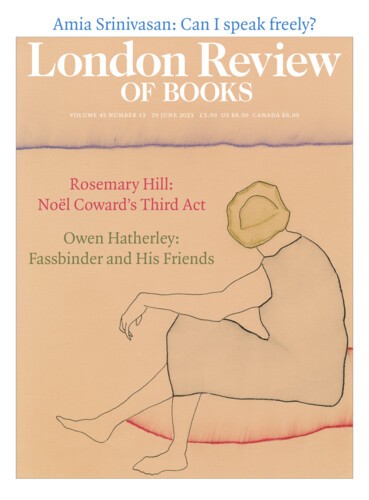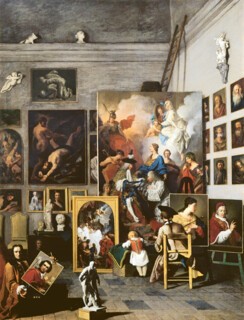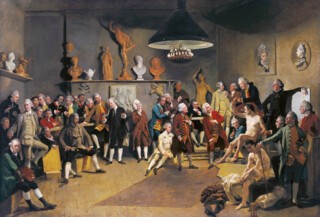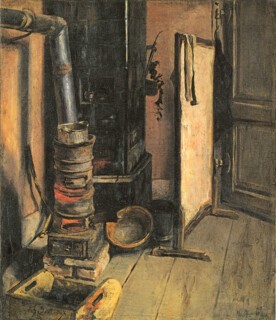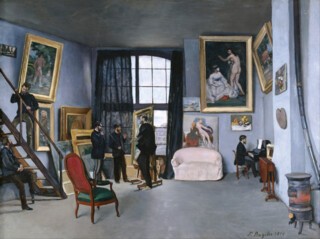On 20 December 1857 , Eugène Delacroix recorded his thoughts on seeing his studio on rue Notre-Dame de Lorette being dismantled. ‘My ambition is bounded by these walls,’ he wrote in his journal. ‘I enjoy the last moments available to me to feel myself still in this place which has seen me for so many years and in which was spent the great part of the latter period of my youth.’ He had spent thirteen years there. Delacroix ‘loved only his studio’, Maxime du Camp said, ‘and it was there he preferred to live.’ Delacroix once described it as a ‘crucible’, in which base substances underwent transformation and mysteries were revealed, ‘in which human genius, at the peak of its development, brings back into question everything that exists’.
Delacroix’s move to rue Notre-Dame de Lorette in 1844 had heralded a period of increased seclusion. The door was guarded by his ‘sentinel’ and housekeeper, Jenny Le Guillou. Yet this withdrawal only incited more publicity and pressure for access. After much effort Baudelaire breached the threshold and was able to ‘penetrate the fortifications of that studio’. While other men craved privacy for vice, he wrote, Delacroix demanded it for ‘drunken orgies of work’. Rather than the fashionable clutter, there reigned ‘a sober solemnity … a softened and subdued light illumined self-communion’. Rapture was only achieved through unrelenting physical effort, to the point of exhaustion, expressive less of passion than of rage. Delacroix’s building had been a gymnasium, and Baudelaire imagined him locked in athletic combat with the obdurate canvas.
There’s not much that is orgiastic about Delacroix’s last studio, on rue de Furstemberg: now a museum in a quiet corner of Saint-Germain-des-Prés, it retains the calm he valued in later life. First opened to the public in 1932, its preservation was an early indication that artists’ studios were becoming part of the patrimony of Paris. But these attractive interiors are also often contrivances. Gustave Moreau bequeathed his house as a museum in 1897, only two years after he had installed the studios upstairs. What the visitor sees at the climax of their visit is not where most of Moreau’s work was produced (in poky garrets), but museum galleries in the guise of studios, in whose vast expanses he wanted posterity to imagine him.
The interplay between real and virtual spaces, material practices and myths, mean that it isn’t an easy task to write the history of the artist’s studio. James Hall’s book touches on many things – self-portraits and celebrity, memorabilia and mirrors – and the physical spaces themselves come in and out of view. In this respect, it’s helpful to know that the term ‘studio’ derives from a verb as well as a noun. Studiolo denoted the scholar’s study or cabinet, but there was also studiare, linked to a certain kind of diligent or pleasurable work, which could take place anywhere. The word ‘studio’ was not used to describe the workplace of an artist until the late 17th century in Italy, and in Britain only from the 19th century, by which time the studio was already breaking out of its familiar four walls and beginning to move (quite literally, if we think of Charles-François Daubigny’s floating workspace on the river). Some studios, like Moreau’s, sloughed off any pretence of domesticity and achieved cavernous proportions. At the 1937 Paris World Fair, where the European dictatorships faced off against one another in monumental combat, Nazi Germany’s pavilion was guarded by a trio of bronze beefcakes (one female) sculpted by Josef Thorak. At once camp and creepy, and standing 22 feet tall, Comradeship was produced in Thorak’s atelier near Munich, designed by Albert Speer. The world’s largest studio, it could accommodate a Zeppelin.
Consciously or not, the studio has always been haunted by its prototypes, which, if we look beyond the narrow case of painting, stretch back to antiquity. Think of Hephaestus in his workshop, forging armour for Achilles while Thetis looks on, or Socrates’ curiosity about Athenian workmen. According to Xenophon’s Memorabilia, Socrates loved being shown the latest techniques in casting, forging, firing and finishing, and then cross-examining artisans such as Simon the Shoemaker, whom he admired as a storehouse of practical wisdom. Subsequent artists invoked Hephaestus to glorify their labours – see the inscription ‘Ab Olympo’ in the courtyard of Andrea Mantegna’s house in Mantua. Meanwhile, Socrates’ inquisitiveness was a gift to theorists who wanted to situate painting within a wider ecology of making. Theophilus, Diderot and Gropius all viewed the craftsman as king, and the workshop as an unparalleled laboratory of observation.
The idea that the artist’s studio was somehow different from the artisan’s workshop took off in the 15th century. In Hall’s phrase, ‘the Renaissance concept of the studio involved a literal and symbolic turning away from the street.’ The most skilful and profitable craftsman of the Middle Ages was the goldsmith, whose reputation for honest dealing was predicated on the transparency of his working practices. Goldsmiths’ shops were open to the street, and to watching customers. By contrast, the 15th-century artist’s studio was premised on a measure of secrecy. This secrecy developed as a complement to the specialist, sometimes arcane knowledge that the artist was expected to acquire, ranging from the knowledge of paint recipes and the mastery of line drawing to the complicated mathematics of perspective and the grisly techniques of anatomical dissection (Vasari states that Michelangelo was ‘constantly flaying dead bodies’). These skills were invoked to justify the growing pretentions of painting as a sacred and scholarly practice, one which counted St Luke as a patron saint and appealed to cultivated princes. After all, hadn’t Alexander the Great visited the studio of Apelles?
Armed with such classical precedents, painters increasingly behaved as a class apart, marked out by their intellectual aspirations, communion with nude bodies and strange habits of working at night. A gothic print of the studio of Baccio Bandinelli – established in Leonardo’s former digs at the Vatican – is the first known representation of an artistic academy. It distils the poses of the new artistic sensibility, showing a windowless, nocturnal ‘ruinscape’ distinguished by dismembered body parts, wild shadows, melancholy introspection and Promethean fire: a school in which the pupils relied not only on their master’s carousel of study collections (drawings, bronzes and casts after the antique) but also on their own stocks of inspiration, or fantasia.
This broad shift in outlook is well-known. What is surprising is how early its implications were grasped and articulated. Cennino Cennini’s Book of Art was written in Padua around 1400, probably with a humanist audience in mind. He dispensed a host of useful tips to aspiring artists, warning of the stink created when you mix red lake with urine to make a paste, the disadvantages of applying paint directly to the human face and the distractions of female company (in their presence, your hands ‘will flutter and flap much more than a leaf does in the wind’). He also urged artists to ‘get yourself a little studietto where no one will bother you at all, and which has just one window covered with [oiled] cloth,’ under which they might set up a desk. This would allow them to work according to their own timetable – without the deadlines so familiar to the artisan in his workshop – and find ‘great enjoyment and pleasure’ in their labour.
For Hall, Cennini is the ‘founding father of slow art’, whose embrace of solitude and laborious perfectionism recalls Petrarch. The art Cennini had in mind was the production of reliquaries, using a technique of gilding and engraving on a clear glass panel known as verre églomisé – he also recommended a neck and chest massage the previous day as preparation for this pious task. But his idea of artists obeying their own rhythms, secluded in their studios-cum-sacristies, quickly found wider application.
Writers such as Cennini, Alberti and Ridolfi give us a theory of the artist’s studio, but what weight should we attach to these sanitised and frequently self-serving representations? Pierfrancesco Alberti’s etching of a painters’ academy in Rome was modelled on Raphael’s School of Athens. Leonardo’s rather superior description of a painter’s residence (‘clean and adorned with delightful pictures’ in which the artist ‘often enjoys the accompaniment of music or the company of the authors of various fine works’) was a far cry from the reality of draughty, dark rooms that stank to high heaven thanks to the mixing of oils, sweat and varnish.
Leonardo’s prescription bore no resemblance to Michelangelo’s chaotic working environment, the ‘incredible filth’ of which was described in a biographical sketch from 1527. It also conveniently obscured the experiences of those who were not reciting verse or strumming lutes but serving the studio in other ways. Cellini’s coercive sexual relations with female and male models are notorious, and in recent years scholars have begun to explore not just the contribution of models as ‘silent partners’, but also the teams of juvenile assistants tasked with mixing gesso, grinding pigments and priming canvases. Some of this hard graft was discharged by the children of the rich, figli di padri, the equivalent of today’s unpaid interns.
Over the course of the 16th century successful artists were increasingly expected to double as courtiers, and so mess and sweat were kept well out of sight; the studio emerged as a stage for the parade of draughtsmanship, learning and manners. Rubens’s house-studio in Antwerp was the locus classicus, his personality stamped not just on the architecture and decorations – the façade representing in grisaille the lost masterpieces of antiquity, as described in the Natural History of Pliny the Elder – but also on the gardens, where he and his adolescent second wife would stroll. As well as two large painting rooms and an octagonal sculpture gallery, the house was fitted with an opening that allowed for canvases to be hoisted between floors, so that he could finish or retouch what his assistants were working on below. In 1621 Otto Sperling reported that ‘the master was working on a canvas while listening to a reading of Tacitus and simultaneously dictating a letter. Since we did not dare interrupt him, he himself addressed us, while continuing to paint, listen to the reading and dictate his letter, as if to give proof of his great ingenuity.’
As the public renown of painters spread, their domestic routines became a spectacle to be gawked at by courts and the international cognoscenti. For female artists, often assumed to be the stooges of their fathers or husbands, painting before an audience was a means of demonstrating autonomy. In May 1664, Cosimo, Grand Prince of Tuscany, joined the visitors who packed into Elisabetta Sirani’s studio in Bologna to watch her paint a breastfeeding scene. Having established the first secular art school for girls after inheriting her father’s studio, Sirani had a lot to prove. We might forgive Cosimo for doubting the hype: in her Record of the Paintings Made by Me Sirani claimed to have completed two hundred canvases and fifteen prints in a decade. That day in her studio the grand prince saw for himself that she had indeed mastered the grand manner of her male contemporaries, and he shared in the outpouring of grief when she died the following year aged 27. Sirani was interred in the tomb of Bologna’s favourite son, Guido Reni (a notorious misogynist).
Female painters could demonstrate their prowess in the studio, but in most places they remained barred from joining the academy as equals (Artemesia Gentileschi joined the Accademia in Florence in 1616, and fifteen women had honorary membership of Bologna’s Accademia Clementina, founded in 1711). For centuries the academies of Europe set the parameters for the ‘systematic studio’, with its props and plaster casts (often preferred to drawing from naked female flesh). When the recently inducted academician Adélaïde Labille-Guiard chose to depict herself seated in the studio in 1785, she was demonstrating to the Salon public that she and the female pupils shown standing behind her had flourished by working in rooms of their own. The erosion of the academic system by market pressures, and its temporary abolition during the French Revolution, accentuated the studio’s function as an entrepreneurial space. In the wonderfully vivid ensembles that Boilly staged in the studios of the painter Isabey (in 1798) and the sculptor Houdon (in 1804) we can see the affirmation of these artists’ professional status, with fashionable but informal sociability substituted for the corporate identity projected by the academy. Boilly presents rooms crowded with friends, colleagues, students of both sexes and family members; in France, the Dictionnaire de l’Académie continued to refer to the atelier as a collective space until 1835.
Elsewhere in Europe, the age of revolutions was giving rise to a different aesthetic, which rejected the idea of the studio as emporium of wonders, or sociable nexus, in favour of Spartan purity. The unlikely father of the ‘white cube effect’ was Casper David Friedrich, whose studio’s one ornament was a T-square dangling from the wall, a reminder of honest German craftsmanship in keeping with his penchant for woodwork and frame-design. Of course, Friedrich’s brand of mystical pietism was partly responsible for this sober aesthetic, and religious impulses compelled other artistic rebels of the same period to purge the studio of ornamental trifles.
In France, a cult of remote antiquity led the Primitifs to rebel against the lingering rococo of their teacher Jacques-Louis David and to embrace reincarnation, vegetarianism and togas. Charles Nodier, their propagandist, proclaimed in 1803: ‘THIS GENERATION IS RISING AND IS DEMANDING CLOISTERS.’ In 1809, a group of German artists swapped the academy in Vienna (fallen to Napoleon’s armies) for a new experiment in communal living at the former monastery of San Isidoro in Rome. Their youthful rebellion entailed wearing monastic robes, vowing celibacy, cultivating facial hair and relearning fresco technique. If the Primitifs looked back to Homeric rigour, the Nazarenes favoured medieval fantasy.
The Christian dimensions of this revivalism lost traction as the 19th century progressed. But the religion of art, and – most of all – the religion of the artist, never went out of fashion. Several of them, including David and Courbet, set up studios on the sites of monasteries and churches, whose ruins covered post-revolutionary Europe. In interviews and photographs Rodin advertised his monastic credentials, describing his cell-like studio near the Dépôt des Marbres as the ‘fraternity house of a new order’. The most evocative account of his famous studio at Meudon comes from his one-time secretary Rilke, who was overwhelmed by ‘this great, light hall with all its white, dazzling figures looking out of the many high glass doors like the inhabitants of an aquarium … one goes about among the many dazzling plaster casts in the very bright pavilion as through snow’.
From here it was a short step to the ascetic studios of the Deutscher Werkbund, a body inspired by medieval guilds, and with its own folksy asceticism and cosmic wellness routines; or to the choreographed charlatanism of Constantin Brancusi, whose studio has formed part of the Centre Pompidou since 1977. Its contrived appearance today is in keeping with a longer history of manipulation. After visiting the studio, Man Ray reported that he was ‘more impressed than in any cathedral. I was overwhelmed by its whiteness and lightness … [It] was like entering another world.’ Brancusi did everything he could to maintain this atmosphere, dressing all in white, sporting a white beard, acquiring a white dog and generally comporting himself like a hermit or a ‘monkish peasant’. The surviving photographs of the interior give little indication of his propensity to entertain young lovers or throw dinner parties there. The power tools he used for polishing and cutting materials are also kept out of sight. In reality, the studio was a technical marvel, with electric motors allowing Brancusi’s metal sculptures to rotate shimmeringly under the glare of carefully concealed lamps.
Hall writes perceptively on the studio’s swagger and ruses, but has less to say about the way they have tended to cluster together. Yet this clustering enabled the dynamism of artistic institutions such as the Louvre (whose concentration of different artists and craftsmen made it an 18th-century Kulturforum), the Villa Medicis and the Bateau-Lavoir. It was also central to the emergence and branding of bohemian neighbourhoods, from Covent Garden and Soho to Montmartre, Neuköln and Chelsea (New York). The story of artists’ studios intersects with the history of real estate, just as it shadows the expansion of other ‘curated’ spaces in late capitalism. Today hairdressers, potters, nail technicians, dental hygienists and personal trainers all aspire to the studio. Like the ‘salon’, the studio is a gentrifying brand, denoting exclusivity, luxury and expensive hardware. It would be a mistake to consider these spaces in isolation.
To its detractors, the studio has always been a bit of a sham. For an insurgent generation in the 1960s, it incarnated a centralising, proprietary, masculinist ideal that had to be overthrown. Feminist practice, land art and conceptual art all proposed new relationships between artists and their environment, as technology eroded the idea of the authenticating touch and postmodernism dumped the idea of the author. Gerard Malanga, Andy Warhol’s astonishingly industrious assistant, compared the studio on East 47th Street to ‘a production line in a surrealist sweatshop’. Warhol’s Factory is at once the climax and the subversion of the story traced in Hall’s book: ‘a windowless hall of mirrors, a beatnik Versailles’ in which every source was covered in tinfoil and silver spray-paint, and where all work was carried out under strobe lights. Appropriately enough, given that the studio had once been an upholsterer’s workshop, the centrepiece was an enveloping red velvet sofa rescued from the street, enjoying a new life as the star of documentaries and dirty movies. The macho artist-labourer shunned soft furnishings, but Warhol made the sofa a queer centrepiece, lounging on it with feline assurance.
In Machine in the Studio (1996), Caroline Jones argued that this marked a tipping point: ‘In place of the saturnine recluse, the artist became an executive, an image manager, or a director of bulldozers and discourse.’ Yet she also warned that the idea had become so freighted with commercial imperatives, male ego and mythic baggage that neither it, nor the ‘auratic mechanisms’ it generated, could be easily dispensed with: ‘the “romance” of the studio is a topos always promising to return.’ Hall too recognises that medieval impulses still surface in the cult of modern art, comparing the relocation of Francis Bacon’s studio from Kensington to the Hugh Lane Gallery in Dublin to the angelic transport of the Holy House of Loreto.
The studio’s resilience might also be explained in pictorial terms. The studio picture, as a category of self-portrait, has for centuries invited weighty meditations on the nature of painting, most famously from Velázquez and Vermeer, who dressed up their rooms as theatres of illusion; in the hands of Courbet, two hundred years later, it functioned as a personal manifesto, a résumé of his career to date and a human comedy that synthesised the social conflicts of the 19th century. By contrast, Frédéric Bazille portrayed his luminous blue-grey studio as a place to hang out, where friends could chat about works in progress and mess about on the piano. For Matisse in the 1910s and 1920s, the attraction of the genre lay in its modesty and mundanity, but the horrors of the outside world seeped in all the more disturbingly because of his efforts at self-enclosure. Employing a broad definition of the studio picture, an exhibition at the Wadsworth Athenaeum in 2001 concluded that Picasso’s experiments in the genre ‘assimilate almost every category of traditional subject matter’, drawing in motifs and fragments from across his life and works. For him, the studio picture was not a refuge, or even a discrete space, but rather ‘a crossroad of events’.
From William Orpen dressing up as Chardin, Jean Cooke’s domestic psychodramas to Lucian Freud’s wall of rags and sinister spider plants, the mix of the banal and the bizarre in studio pictures is often what makes them interesting. Last year the Orangerie in Paris held a retrospective of the work of Sam Szafran, a Parisian painter born to Polish-Jewish parents, who in the wake of the Second World War began obsessively to depict the rooms in which he lived and worked, subjecting them to ominous distortions. In these works he created an architecture of unreality, precise yet hallucinatory, with labyrinthine staircases, net-like glass roofs and studios so overrun by vegetation as to resemble jungles. Such pictures are born of the artist’s absorption in and complicity with their physical surroundings. They couldn’t be made anywhere else.
Send Letters To:
The Editor
London Review of Books,
28 Little Russell Street
London, WC1A 2HN
letters@lrb.co.uk
Please include name, address, and a telephone number.
